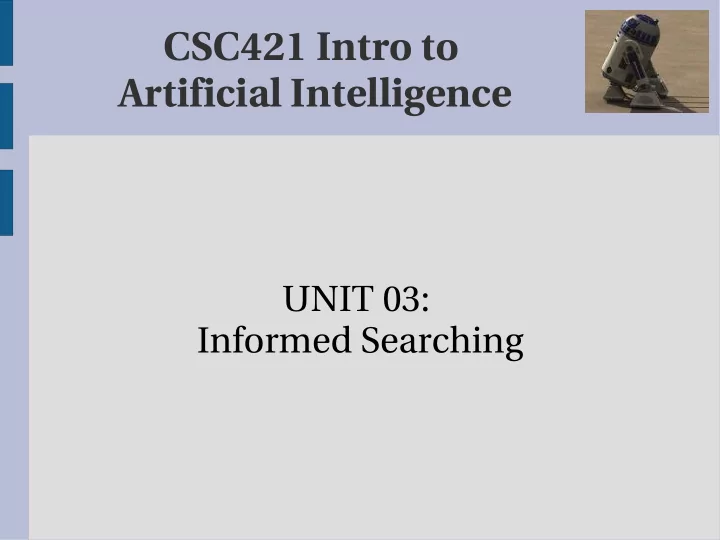

CSC421 Intro to Artificial Intelligence UNIT 03: Informed Searching
Review ● Review Strategy = picking the order of node expansion
Mini-test A C B D E F G
Mini-test A C B D E F G BFS: FIFO fringe = [A]->[B,C]->[C,D,E]->[D,E,F,G]->... Order of nodes visited: ABCDEFG
Mini-test A C B D E F G DFS: LIFO fringe = [A]->[B,C]->[D,E,C]->[E,C]->[C]->[F,G] Order of nodes visited: ABDECFG
Mini-test A C B A ABC ABDECFG D E F G IDS: Multiple DFS up to depth Order of nodes visited: AABCABDECFG
Best-first search ● Idea: use an evaluation function for each node – estimate of “desirability” ● Expand most desirable unexpanded node ● Implementation: – Fringe is a queue sorted in decreasing order of disirability ● Special cases: – Greedy search – A*-search
Map with step costs and straight-line distances to goal
Greedy Search ● Evaluation function h(n) (heuristic) = estimate of cost from n to goal ● E.g., h SLD (n) = straight-line distance from n to Bucarest ● Greedy search expands the node that appears to be closest to goal
Greedy Search Example
Greedy Search Example
Greedy Search Example
Properties of Greedy Search ● Complete: no it can get stuck in loops – however complete with repeated state checking ● Time: O(b m ) but good heuristic can give dramatic improvements in many cases ● Space: O(b m ) ● Optimal: No, why ?
A-* search ● Idea: avoid expanding paths that are already expensive ● Evaluation function f(n) = g(n) + h(n) – g(n) : cost so far to reach n – h(n) : estimated cost to goal from n – f(n) : estimated total cost of path through n to goal ● A-* search needs to use an admissable heuristic i.e always <= true cost ● For example h SDL is always less than the true distance (at least in Euclidean geometry) ● Theorem: A* is optimal
A* example
A* example
A* example Gradually adds f-contours of nodes Nice easy optimality proof read the book
A* properties ● Complete: Yes, unless there are infinitely many nodes with f <= f(G) ● Time: exponential in [relative error in * length of solution] ● Memory: Keeps all nodes in memory ● Optimality: yes ● Problems – Exponential growth for most optimal solution – Sometimes good-enough ok (suboptimal) – Memory-intensive (read book for some approaches to reducing memory load)
Admissable Heuristic ● e.g., for the 8-puzzle – h 1 (n) = number of misplaced tiles – h 2 (n) = total Manhattan distance (i.e #squares from desired location of each tile) h 1 (S) = ? h 2 (S) = ?
Dominance ● If h 2 (n) >= h 1 (n) for all n (both admissable) then h 2 dominates h 1 is better for search ● Typical search costs: – D=14 ● IDS 3,473,941 nodes ● A*(h1) = 539 nodes ● A*(h2) = 113 nodes
Relaxed problems ● Admissable heuristics can be derived from the exact solution cost of a relaxed version of the problem ● If the rules of the 8-puzzle are relaxed so that a tile can move anywhere then h1 gives the shortest solution ● What about h2 ? ● Key point: the optimal solution cost of a relaxed problem is no greater than the optimal solution of the real problem
Summary ● Heuristic functions estimate costs of shortest paths ● Good heuristics can dramatically reduce search cost ● Greedy best-first search expands lowest h – Incomplete, not always optimal ● A* search expands lowest g + h – Complete and optimal ● Admissable heuristics can be derived from the exact solution of relaxed problems
Recommend
More recommend